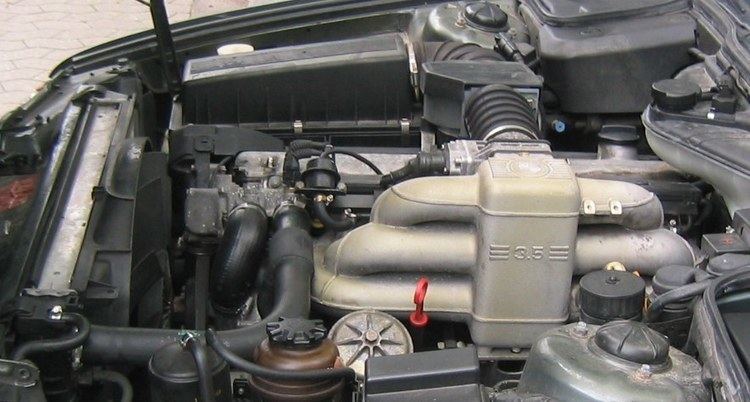Manufacturer BMW Successor BMW M60 V8BMW M50 | Production 1968–1994 Predecessor None | |
 | ||
The BMW M30 is a straight-6 SOHC piston engine which was produced from 1968 to 1994. The first model to use the 2494 cc version of the M30 was the E3 2500. Over its 28-year lifespan, the M30 was used in many BMW models. Although there was no direct replacement for the M30 engine, effectively the v8 M60 and straight-6 M50 (smaller capacity than the M30, but with DOHC) took over from the M30.
Contents
Initially, the engine code was "M06", before it was renamed the M30 in the mid 1980s. The engine has been given the nicknames of 'Big Six' and 'Senior Six', following the introduction of the smaller BMW M20 straight-6 in the late 1970s.
Ward's have rated the M30 as one of the "Top Engines of the 20th Century".
Development
The M30 was originally developed in the late 1960s, loosely based on the straight-four BMW M10 engine first used in the 'Neue Klasse' BMW 1500. Several features, including a 30-degree cam to the right for a lower profile, a crossflow head and a gas flow head in later models design, and a chain-driven single overhead cam with rocker arm valve actuation, are common between the M10 and the M30. Further similarities include a cast-iron block with an aluminium head and a forged crankshaft. The first two engines introduced were the 2.8 and the 2.5 litre option, both short-stroke engines sharing a common bore.
2.5 litre
The first model to use the 2494 cc version of the M30 was the E3 2500 in 1968. Unless otherwise noted, these engines use a carburetor.
Applications:
2.8 litre
A 2.8 litre version of the M30, this appeared in 1968 in the then new E3 2800 and E9 2800CS. It has a bore of 86 mm, a stroke of 80 mm and a displacement of 2,788 cc (170.1 cu in). In the E24 628 CSi, it uses Bosch L-Jetronic fuel injection. Originally, two Solex Zenith "35/40 INAT" carburetors are used, the compression ratio is 9.0:1 and the engine produces 170 PS (125 kW) and 24.0 kg·m (235 N·m; 174 lb·ft).
Applications:
3.0 litre
This version was produced from 1971 until 1992. It has a bore of 89 mm, a stroke of 80 mm and a displacement of 2986 cc. The first model to use the carburetted version of the 3 litre M30 was the E9 3.0CS. There was also the first fuel-injected M30 version for the CSi and later Si models, which uses the Bosch D-Jetronic fuel injection system.
Applications (carburettor):
M30B32
Despite having a capacity of 3210 cc, this engine appeared in many cars badged so as to suggest 3.3 litres of displacement, such as the 633i, 3.3 Li, and 733i. It has a bore of 89 mm, a stroke of 86 mm and a capacity of 3210 cc. In the E24 633CSi, it uses Bosch L-Jetronic fuel injection. The US version used L-Jetronic from 1978 until mid-1981, changing over to Motronic fuel injection in June of that year. The 1979 732i is BMW's first use of Bosch's Motronic fuel injection.
Applications:
M30B34
This engine has a bore of 92.0 mm, a stroke of 86.0 mm and a displacement of 3428cc. In the E24 635CSi, it uses Bosch Motronic 1.0 fuel injection.
Without catalytic converter
The version sold in Europe and most other markets used a 10.0:1 compression ratio and produced 160 kW (210 hp).
Applications:
With catalytic converter
The version sold in markets such as North America and Japan used an 8.0:1 compression ratio and produced 136 kW (182 hp).
Applications:
M90
The following models use a variant of the M30 coined the M90. This engine is actually 3453cc and uses the same block as the BMW M88/S38 . It does, however, use a SOHC head and was regarded as the test horse platform before the production of the M88/S38 in order to determine if the "oversquare" engine setup would work reliably.
The differentiation of this engine is coolant water passages on the side of the block (not otherwise seen on an M30B32/B34), and/or a white L stamped on the oil filter side of the block. It used both L-jetronic and Motronic injection systems, depending on the year.
The engines sold in Europe and most other markets (except North America) used a compression ratio of 9.3:1, did not have a catalytic converter and produced 160 kilowatts (210 hp).
Applications:
M30B35
It has a bore of 92 mm, a stroke of 86 mm and a capacity of 3428 cc. In the E24 635CSi, it uses Bosch Motronic 1.3 fuel injection.
Applications:
Turbocharging
The M30 was the basis for the turbocharged M102 and M106 engines.
The Alpina B10 Biturbo used a modified version of the M30, with two turbochargers and forged pistons. Producing 265 kW/360 hp at 6000 rpm and 520Nm/384 lb-ft at 4000 rpm, the engine made this car the fastest sedan in the world. The final 50 M30 blocks were shipped to Alpina for use in the final 50 B10 Biturbos.
Motorsport
The M30 powered a series of BMW 6-cylinder E9 and BMW E24 coupes to European Touring Car Championship (ETCC) throughout the 1970s and into the middle 1980s, even though a more powerful DOHC 24-valve head had been developed for high-performance motorsports and street use.
The BMW M88 high-performance engine is based on the M30 block.
